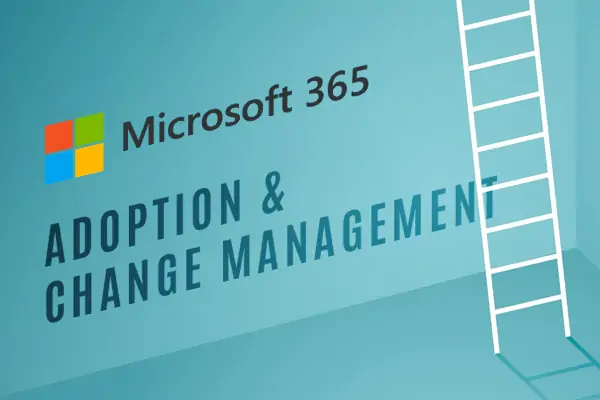Adoption and change management.
Leverage the full value of your intranet and technology investment with an intrinsic adoption and change management approach that ensures your technology is built for people and used by people.

Intranets and workplace technologies can provide a business with a powerful set of capabilities, from internal communications, collaboration, automation and self-service functionality, to being fully optimised for mobile devices and connecting a workforce from any location.
However, despite all the powerful features and attributes new technology has to offer, it doesn't guarantee adoption from users.
Good levels of adoption requires efforts to influence both the hearts and minds of busy employees so they know how, when and why to use the new digital workplace tools at their fingertips. It’s also worth noting that “adoption” is not just about getting higher numbers of active users, but also about using tools in the best way possible to drive productivity and achieve positive outcomes.
At Content Formula we believe adoption and change management must be tightly woven into technical projects, with continued emphasis on the end-user to ensure technology is built for people and used by people so that organisations are able to reap the true value and return from their technology investment.
Launching a new workplace technology is always a big investment and organisations expect to see a quick return (ROI). However, executives nearly always base their ROI calculations on broad adoption of the new tech but they rarely include spend on driving that adoption.
Intranets and other digital workplace technologies can often appear complexed and daunting to new users, and it can be tempting for them to stick to old habits and ways of working.
In addition to this, many organistions have a diverse userbase, often including front line workers, desk workers, managers, content editors who all have different priorities and objectives when it comes to using the new technology. Not planning for this complexity and diversity can lead to low adoption rates.
At Content Formula, our Adoption and Change Management (ACM) service allows organisations to embed tech change through understanding users and putting in place activities that engage them. Our approach focuses on:

Adoption and change management is integral when rolling out new technology within an organisation. Achieving return and value from the investment of technology is dependent upon adoption at scale. This involves teaching people to use new tools and working in new ways to embed widespread change.

Putting employees at the centre, not technology.
Change and adoption is about people, not technology. The digital workplace or 365 tool that you are expecting people to use must be people-centred, with a good user experience and no technology-related barriers to use. Any adoption campaign must also put people at the centre and be targeted around their needs.

Understanding employees and their pain points
A thorough understanding of employees and their pain points, conducted through user and stakeholder research, is important to not only shape the tools they use, but also design an impactful ACM campaign. For example, focusing on use cases which resonate with particular groups can illustrate the value of using a particular tool.

Training and support
Usually, there will be some kind of training involved in change management, whether for champions, super-users, site admins, content publishers or even on a “train the trainers” basis. Training is not necessarily required for users, but some ongoing support whereby they can ask questions might be, alongside making self-serve resources available.

Measurement
Measurement is an important part of adoption and change management. You need to apply the right measures and metrics to know whether adoption and usage is reaching required levels, and to subsequently target additional interventions and communications if they are not. Measurement also needs to be sustained as adoption patterns change over time.

Top-down and bottom-up communications
Generally, a good ACM plan will incorporate both top-down communications from senior leaders to show a tool is endorsed and is a company priority, and bottom-up communications from peers and champions that are more likely to resonate with different locations and groups.

A formal plan
Having a formal ACM plan (and related communications plan) that all stakeholders buy into is critical in order to execute successful 365 adoption and change management. This ensures you can co-ordinate efforts across different stakeholders and communication channels, but also change the focus over time as adoption and behaviours evolve. At Content Formula, we use the ADKAR change model as a basis for our planning, a popular framework with five stages – Awareness, Desire, Knowledge, Ability and Reinforcement. Microsoft also advocates for the use of ADKAR.

Targeting efforts
It’s important to target your ACM effort to different groups. We advise using key personas to maximise the impact of messaging.

Engaging communications
Successful ACM initiatives rely on good communications. These need to be engaging to stand out and have an impact. Use of video, imaginative assets and relevant, targeted copy can all make a difference.
Our adoption and change management leverages the ADKAR framework designed by Prosci and popularised by Microsoft. It aims to take all target users through each of the steps in a structured and accelerate way.
Awareness
Bring about awareness. Communicate the need for change and provide a clear explaination for the reason behind it and the benefits it will bring. Provide opportunity for employees to ask questions and put forward ideas and suggestions.
"Have you heard of the proposed change?"
- Announce the change to employees
- Be aware of customer/industry pressure
- Explain reasoning behind change
- Provide opportunity for employees to ask questions and make suggestions
Desire
Champion the change and help other to understand the personal benefits it will bring to them, so that they desire it too and are less resistent to change and more likley to let go of old habits.
"I am excited to get on board"
- Announce the change to employees
- Help employees get ready for a change
- Help employees to consider 'What's in It for me'?
- Gauge employees reactions to the change
- Identify risks and address fears
- Build momentum
Knowledge
Provide training and knowledge to employees about how their responsibilities, technology and processes may be impacted by the change.Facilitate the new ways of working.
"I have attended the training session and feel more confident"
- Announce the change to employees
- Help employee understand the software/change
- Provide training material and sessions
- Provide demos
- Appoint examples and role models ‘change champions’
Ability
Encourage and help employees feel competant and confident in their ability to execute the change. Provide coaching and feeback to help build skills and confidence.
"I am using the software daily now"
- Announce the change to employees
- Encourage employees to practice applying new skills
- Help employees get used to using new processes
- Provide regular training of the basics
- Provide coaching
- Provide opportunity for Feedback
Reinforcement
Continue to provide positive reinforc before and after the change. Celebrating the success of the transformation to maintain enthusiasm and motivation.
"I am complemented for incorporating this change"
- Announce the change to employees
- Provide rewards and incentives
- Provide ongoing/future support
- Celebrate the change and the benefits it will bring
- Announce personal recognition
At Content Formula, our ACM services cover everything you need to embed change in the best possible way and drive secure transformation, supporting users and leading them successfully through change.

















